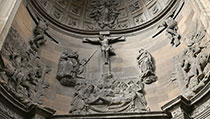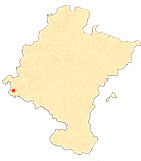Front façade of the parish church of Santa María de Viana
Calvary and Holy Burial
In the central part of the second body is the scene of Calvary, centred by the figure of the crucified Christ, on a large cross topped by the cartouche with the registration INRI, with three nails, with a suffering but already dead gesture, with his head on his shoulder, long hair and crown of thorns. He is wearing a flowing cloth of purity, with his arms in a v-neck and Anatomy marked, reflecting the tension of the moment. To his right is Saint Longinus, ready to pierce Christ's side with his lance, and next to him is the group of the Marys, with the Virgin imploringly, while being consoled by Mary Cleophas. On the other side, to the left of Christ, is Saint John, with his hand on his chest, while Mary Magdalene is shown embraced at the foot of the cross, in a disconsolate attitude, with her hair loose. At either end are the figures of the Good Thief and the Bad Thief, Dimas and Gestas, both crucified but tied with ropes, with muscular, mature, bearded bodies. The former has serene and beautiful features, while the latter's expression already reflects his condemned condition. Just below the two thieves are depicted two groups of soldiers, one of them emerging from a walled city, in practically symmetrical compositions that can be identified as the Roman soldiers who guarded Christ's crucifixion.
Below this scene, and superimposed on the body of the Magdalene, is the group of the Holy Burial. It is a balanced and symmetrical composition, centred by the inert body of Christ, behind which the Virgin Mary is represented, consoled by Saint John and Mary Cleophas, while on either side are Nicodemus and Joseph of Arimathea, both accompanied by angels, who look towards the upper part, where the Crucified Christ is represented.
issue The iconography of Calvary is one of the most widely represented themes in Christian art, with a variety of figures in its composition, from the broadest to the solitary figure of the Crucified One. This is because the figure of Jesus on the cross is the symbol of the salvation and redemption of mankind, the neuralgic point of Christian doctrine and the main topic of this portal, through the sacrifice of Christ.
-
ESTEBAN LORENTE, J.F., "El arco de ingreso de la colegiata de Santa María de Viana. Horóscopo de Cristo", Berceo, 130, 1996, pp. 177-178.
-
ESTEBAN LORENTE, J.F., "Los dioses paganos en las iglesias españolas del siglo XVI", bulletin del Museo e high school Camón Aznar, LXXXII, Zaragoza, high school Camón Aznar, 2000, pp. 157-190.
-
FERNÁNDEZ GRACIA, R., (coord.), ECHEVERRIA GOÑI, P.L., and GARCÍA GAINZA, M. C., El arte del Renacimiento en Navarra, Pamplona, Gobierno de Navarra, 2005, pp. 111-114.
-
GARCÍA GAINZA, M. C., HEREDIA MORENO, M. C., RIVAS CARMONA, J. and ORBE SIVATTE, M., Catalog Monumental de Navarra. V. II**. Merindad de Estella, Pamplona, 1980, pp. 559-564.
-
GONZÁLEZ DE ZÁRATE, J. M., "Aproximaciones a la lectura iconográfica del programa mitológico en la portada de Santa María de Viana", Primer congress General de Historia de Navarra, anejo 11, Pamplona, Príncipe de Viana, 1988, pp. 179-196.
-
LABEAGA MENDIOLA, J.C., Viana monumental y artística, Pamplona, Príncipe de Viana, 1984, pp. 229-236.












